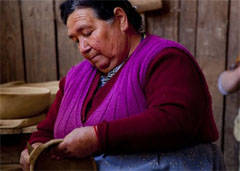The Convention for the Safeguarding of Intangible Cultural Heritage

Bicicleta de cuasimodista (Fiesta de Cuasimodo). Isla de Maipo, Chile. Foto: © UNESCO/Carolina Jerez
The Convention for the Safeguarding of Intangible Cultural Heritage was passed by the UNESCO General Conference held in 2003. At that time, the international community recognised the need to raise awareness about cultural manifestations and expressions that until then had no legal or programmatic framework to protect them.
Along with other international instruments that protect cultural heritage – such as the Convention concerning the Protection of World Cultural and Natural Heritage – the 2003 Convention is aimed at safeguarding the uses, representations, expressions, knowledge and techniques that communities, groups and, in some cases, individuals, recognise as an integral part of their cultural heritage. This intangible heritage is found in forms such as oral traditions, performing arts, social practices, rituals, festive events, knowledge and practices concerning nature and the universe, and traditional craftsmanship knowledge and techniques.
This definition, which is provided in Article 2 of the Convention, also comprises the instruments, goods, objects of art and cultural spaces inherent to intangible cultural heritage. This conceptualisation was discussed in the lengthy negotiations and discussions that served as the basis for the Convention.

© Consejo Nacional de la Cultura y las Artes, Chile
Article 16 of the 2003 Convention grants authority to the UNESCO Intergovernmental Committee for the Safeguarding of Intangible Cultural Heritage to compile a Representative List of Intangible Cultural Heritage, aimed at better understanding the intangible cultural heritage around the world.
Around the world, 150 States have joined the 2003 Convention, while it has been ratified or passed in 28 countries within Latin America and the Caribbean (group III). Through its acceptance, the countries agree to adopt a general policy aimed at highlighting the function of intangible cultural heritage in society.
